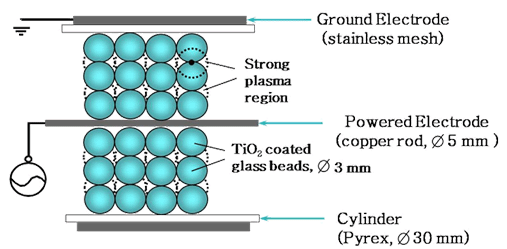|
|
|

|
| Aerosol Formation in Nonthermal Plasma Processing for NOx and SOx Removal |
Increasing concern over the emission of air pollutants into the atmosphere has motivated the research into environmentally acceptable and energy-efficient methods to remove these gases from atmospheric pressure gas streams. Non-thermal plasma technique has the great possibility to realize the pollution control of exhaust gases. In the non-thermal plasmas even though the electrons are short-lived under atmospheric pressure conditions and rarely collide with the pollutant molecules, they undergo many collisions with the dominant background gas molecules (N2, O2, H2O) and produce reactive radicals (N¡Ü, O¡Ü, OH¡Ü, O3¡Ü HO2¡Ü etc.) by electron-impact dissociation and ionization reactions. The NO and SO2 decompose by the reactions with these reactive radicals to produce mainly NO2 and SO3 as products. NH3 is provided to investigate the formation of NH4NO3 and (NH4)2SO4 particles.
|
 |
Non-thermal plasma reactor packed with photocatalysts for NO, SO2 removal
|
The removal of air pollutants, such as NO and SO2, can also be enhanced by the combination of non-thermal plasma process and TiO2 photocalalysts. TiO2 NPs are well known photocatalysts which exhibit a band gap (3.2 eV) and cover the redox potential of the H2O/OH couple (-2.8 eV), thus promoting the breakdown of many compounds. Non-thermal plasma can be a source of UV light for activation of TiO2 photocatalysts in non-thermal plasma-photocatalysts hybrid system. For high efficiency of air pollutant removal in the non-thermal plasma-TiO2 photocatalysts hybrid system, TiO2 photocatalysts should be coated uniformly on the surface of substrate beads (ie glass, polypropylene) by using an efficient particle coating process (ie ICP-CVD). The NO and SO2 removal by non-thermal plasma reactor packed with TiO2 photocalalysts is analyzed theoretically and experimentally. |
|
|
|
|
|
|
